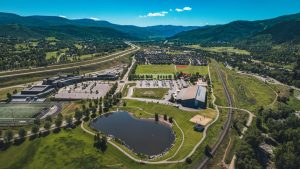Vail doing ‘OK’ on housing, but still has work to do
Housing in Vail is tough, but solutions exist

Supporters of Vail Resorts’ effort to build workforce housing in East Vail are criticizing the Vail Town Council for attempts to block the project. But the town has a long track record of successfully building employee housing and pioneering initiatives to help local workers get into the market.
The list, dating from the 1990s-era Vail Commons project above City Market in West Vail, is fairly extensive, accounting for some 600 for-sale and rental homes among 11 different developments.
George Ruther, the town’s housing director, said as the fourth-largest employer in the Vail community, the town has a need and a responsibility to provide home ownership and rental opportunities for its workforce. The list of workforce housing projects the town has constructed or purchased range from the big (142 rental units at Middle Creek; 114 rental units at Lion’s Ridge Apartments; 96 rental units at Timber Ridge Village; 53 for-sale units and 18 rentals at Vail Commons) to mid-sized (24 rental homes at Buzzard Park; 32 for-sale homes at Chamonix Vail; 18 for-sale homes at Red Sandstone Creek Townhouses) to the small (six for-sale homes at North Trail Town Homes; two for-sale homes at the Arosa Duplex).
Included among those 600 units are the 72 rental units set to come online at the Residences at Main Vail, the alternative workforce housing development that town officials hoped to partner with Vail Resorts on as a way to avoid developing the East Vail parcel.
The town also launched its highly successful Vail InDEED program in 2018, which relies heavily on public/private partnerships to increase the supply of homes. The program has helped to increase the supply of homes dedicated to Vail residents by nearly 50%, at a total investment of more than $12 million. Some 380 residents and their families have found homes in Vail through the program.

Support Local Journalism
Still, Vail officials and workforce housing advocates say there’s more to be done.
Longtime Vail housing advocate Steve Lindstrom chairs the board of directors for the Vail Local Housing Authority, and has served on that board since about 2001. In that position, he’s seen a lot done, and a lot delayed or shot down, in regard to workforce housing.
Lindstrom said the town’s efforts over the years are “OK.” But, he added, there’s a lot more to do.
“We’re doing better than a lot of our peers, given our constraints,” Lindstrom said. The biggest of those constraints is Vail’s lack of available land within the town’s boundaries.
Lindstrom said the town needs to start “creating” land, primarily working with property owners.
That, rather than looking west of town, needs to be a major focus, Lindstrom said.
Efforts to look west so far haven’t yielded much, Lindstrom said.
“So much is beyond our control,” he added.
In town, there have been any number of failures to launch workforce housing efforts.
A red tape problem
Some can be traced to the town approval processes.
Lindstrom noted that a project proposed in 2021 for the tennis courts at Cascade Village didn’t make it past its first meeting with the Vail Planning and Environmental Commission.
The Vail Town Council later urged a restart of the process, but by then the proposed developer had abandoned the project.
Vail resident Bobby Lipnick chairs the Eagle County Housing Task Force, a group of private and public figures dedicated to more workforce housing in the valley. Lipnick also lives near the Cascade tennis courts.
Lipnick said at one point he sat on the court with the proposed developer, and it saddens him that the project failed.
But some of those failures over the years can be traced to Vail Resorts.
Lindstrom noted that conversations over the years with local managers for the company have started with some enthusiasm, then fizzled out when ideas went to company headquarters in Broomfield.
“At this point, the folks in Broomfield have to spin the globe to find Vail,” he added.
While East Vail is the focus at the moment, both Lindstrom and Lipnick said there are options available to both the town and resort company. One most often mentioned is using part of the 10-acre parcel that once made up the Ever Vail project. That site would give workers walking access to jobs, restaurants and other businesses.
Lipnick opposed the Vail Town Council’s May 3 move to start condemnation proceedings on the East Vail parcel. But, he said, that site involves a lot of work on the site before anything can be built.
‘There are better places’
“There are better places,” Lipnick said. “And it breaks my heart personally to see the community torn up over (the issue).”
No matter what happens with the East Vail parcel, both Lipnick and Lindstrom said Vail, Eagle County and the rest of the valley’s towns need to keep working.
Housing at this point is a matter of economic survival, Lindstrom said.
“Vail has a lot of services the world wants,” Lindstrom said. “Our problem is providing that service. You can’t do it from afar.”
Lindstrom said service — which means housing for those who provide it — should be the town’s “secret sauce.”
And, despite the current challenges, Lipnick said he’s “optimistic” that solutions can be found.
Talking about the current conflict between Vail Resorts and the town of Vail, Lipnick said officials from both sides should be locked in a room and not let out until they find some kind of partnership.
Ultimately, he added, the valley’s local governments need to find both the funds and the policy will to work with private sector partners.
“They realize that workforce housing is truly at a crisis level,” Lipnick said. “If we keep going the way we’re going … I worry that we’re not going to have the community that we’ve grown to love.”











